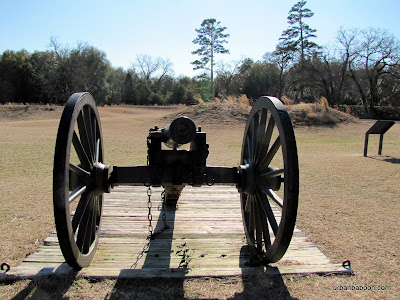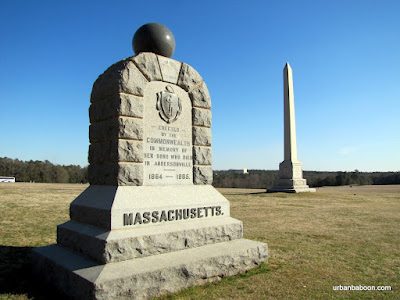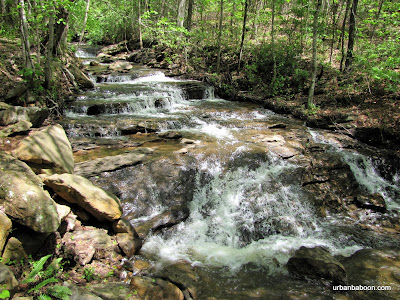 |
| From Andersonville |
I’m a fan of Mr. George Santayana’s work, using one of his quotes, everyday since day one of this project on the front page. Probably, the most often quoted piece of his wisdom is “Those who cannot remember the past are doomed to repeat it.” In this light, I like to embrace the good and the bad of our collected behavior, with a slight emphasis on the bad, which we tend to want to forget or to change, so we don’t feel as “icky” about ourselves in hindsight. Earlier this year I traveled to a place that can lay claim, albeit dubiously, as one of the worst moments of our collective culture, and certainly Georgia history, and I did this at a time where more and more I hear people rooting on the mistreatment of prisoners. The irony, the history, and the sadness is palpable at the Andersonville Civil War Prison . The content of this visit is so grand that I will discuss it in three parts, even though it is easily visited in one setting). This is part one: National Prisoner of War Museum and Andersonville Prison.

It sits 129 miles South of Atlanta, just over two hours away near the peaceful middle Georgia towns of Americus and Plains. There is no cost to enter save the time required to arrive and visit, so I consider it a shame on me for waiting until 2010 to visit (not even a parking fee). When you arrive, you first enter the National Prisoner of War Museum with the sacred land of Andersonville placed right behind it.

The Prisoner of War museum is a fitting tribute to POW’s and perfectly placed at the foot of the infamous Civil War Prison. It truly sets the tone for what you are about to see. And no, it is not dedicated only to the Civil War POW’s. There are displays from virtually every war since. There’s amazing artifacts showing how POW’s survived from food to grooming to toilet paper. There are a couple of facsimiles of cells: one in concrete, one in Vietnam Bamboo. There’s an amazing dark room that uses lighting tricks to try to get you to understand what life might be like to live constantly with a gun in your face. There are correspondences from soldiers who tell their tales. Utilizing an hour of your time in this building will get your mind right for viewing what comes next.

When you exit behind the museum you are confronted with the place that as many as 33,000 Union Soldiers were imprisoned. The first impression is probably the same impression the Confederates who decided on the as the place for the building of a prisoner encampment: a bucolic green field with a small stream running through it. What it was to become was probably more difficult for them to imagine that the modern viewer because of our historical knowledge. On the left side is a depiction of one corner of the stockade walls. Outside the walls is a pillory; inside the walls are makeshift tents called “Shebangs” which are the type of sticks and cloth structures used by the captured soldiers to fend of the Georgia heat. Along the whole of the concourse is the stockade line and deadline: a phantom line today but if crossed at the wrong moment of history meant death by gunshot from guards placed in the towers because any attempt to approach the walls meant attempt at escape.

On the backside of the walk, there is a star fort where the commandant of the prison could survey his charges, complete with two replica cannons. There is also the land where the hospitals for the sick were kept. There is another stockade wall on the right side this one depicting entry in the prison camp. Near this stockade is a stonework temple housing Providence Spring , a gift of water to the inmates, that seemingly came from nowhere to give drink to those in desperate need of water. On the near right side is a sort of monument park, erected granite commemorating each states contribution to the internment and dead at the prison. Among these are trees that have types of tunnels built at their base showing the way a prisoner might dig to escape. There are actually a number of small granite markers throughout the site marking filled in water wells or escape tunnels depending on your viewpoint.

The prison was a difficult place to live and a difficult place to face even in the 21st Century. Pictures of emaciated inmates seen either online or in the museum are difficult to forget. The stories of mistreatment and even prisoners roughing up other prisoners are sickening. It makes me think of my family and friends who have served this country past and present. It makes me think of John McCain. It makes me think of the stories about us at Abu Ghirab and Gitmo, but I digress.

I know there are a lot of causes for the starvation and sickness that ran rampant through this camp, and I won’t pass judgment. I know Captain Henry Wirz was following orders and had limited supplies. I know that the North refusing to recognized the Confederate Nation led to the end of prisoner exchange and the swelling of the ranks at the Camp. I know about the Union’s version of Andersonville at Camp Douglas in my hometown. The bigger picture is what weighs heaviest on my mind: Of what are we made that allows us to act this way toward our fellow man? Do we have the dignity and courage to rise above this flaw in our makeup and become the noble beast I think we all want to become? Is the past prologue? Do we ever learn? Does one person’s abandonment of morality give me the moral authority to do likewise? Can two wrongs actually make a right?

The history of the place is easy to find and I will include some links (here , here , and here ), I wanted to simply give you an impression. The walk is paved and only gently graded and runs about 1.5 miles. If you can’t walk it, you can drive for most of it. I would place this historic site on the list of must see, not simply nice to see or ought to see.






